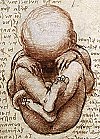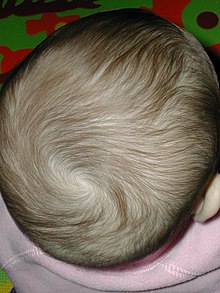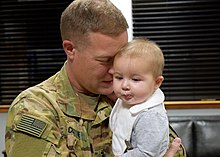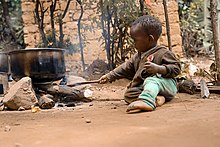Infant

| Part of a series on |
| Human growth and development |
|---|
 |
| Stages |
| Biological milestones |
| Development and psychology |
An infant or baby is the very young offspring of human beings. Infant (from the Latin word infans, meaning 'baby' or 'child'[1]) is a formal or specialised synonym for the common term baby. The terms may also be used to refer to juveniles of other organisms. A newborn is, in colloquial use, an infant who is only hours, days, or up to one month old. In medical contexts, a newborn or neonate (from Latin, neonatus, newborn) is an infant in the first 28 days after birth;[2] the term applies to premature, full term, and postmature infants.
Infants born prior to 37 weeks of gestation are called "premature",[3] those born between 39 and 40 weeks are "full term", those born through 41 weeks are "late term", and anything beyond 42 weeks is considered "post term".[4]
Before birth, the offspring is called a fetus. The term infant is typically applied to very young children under one year of age; however, definitions may vary and may include children up to two years of age. When a human child learns to walk, they are called a toddler instead.
Other uses
In British English, an infant school is for children aged between four and seven.
As a legal term, infancy is more like minority, and continues until a person reaches 18 years of age.[5]
Physical characteristics
This section needs additional citations for verification. (March 2022) |
A newborn's shoulders and hips are wide, the abdomen protrudes slightly, and the arms and legs are relatively long with respect to the rest of their body.
Head

A newborn's head is very large in proportion to the body, and the cranium is enormous relative to his or her face. While the adult human skull is about one seventh of the total body length, the newborn's is about 1⁄4. Normal head circumference for a full-term infant is 33–36 cm at birth.[6] At birth, many regions of the newborn's skull have not yet been converted to bone, leaving "soft spots" known as fontanels. The two largest are the diamond-shaped anterior fontanel, located at the top front portion of the head, and the smaller triangular-shaped posterior fontanel, which lies at the back of the head. Later in the child's life, these bones will fuse together in a natural process. A protein called noggin is responsible for the delay in an infant's skull fusion.[7]
During labour and birth, the infant's skull changes shape to fit through the birth canal, sometimes causing the child to be born with a misshapen or elongated head. It will usually return to normal on its own within a few days or weeks. Special exercises sometimes advised by physicians may assist the process.
Hair

Some newborns have a fine, downy body hair called lanugo. It may be particularly noticeable on the back, shoulders, forehead, ears and face of premature infants. Lanugo disappears within a few weeks. Infants may be born with full heads of hair; others, particularly Caucasian infants, may have very fine hair or may even be bald. Amongst fair-skinned parents, this fine hair may be blonde, even if the parents are not. An infant's hair color and texture can change: red can give way to blond, curly can go straight, and thick, dark hair could reappear a lot sparser and lighter.[citation needed] The scalp may also be temporarily bruised or swollen, especially in hairless newborns, and the area around the eyes may be puffy.
Length
In developed countries, the average total body length of a newborn is 35.6–50.8 cm (14.0–20.0 in), although premature newborns may be much smaller.
The way to measure a baby's length is to lay the baby down and stretch a measuring tape from the top of the head to the bottom of the heel.
Weight
In developed countries, the average birth weight of a full-term newborn is approximately 3.4 kg (7+1⁄2 lb), and is typically in the range of 2.7–4.6 kg (6.0–10.1 lb).
Over the first 5–7 days following birth, the body weight of a term neonate decreases by 3–7%,[8] and is largely a result of the resorption and urination of the fluid that initially fills the lungs, in addition to a delay of often a few days before breastfeeding becomes effective. After the first week, healthy term neonates should gain 10–20 grams/kg/day.[8]
Skin

Immediately after birth, a newborn's skin is often grayish to dusky blue in color. As soon as the newborn begins to breathe, usually within a minute or two, the skin's color reaches its normal tone. Newborns are wet, covered in streaks of blood, and coated with a white substance known as vernix caseosa, which is hypothesised to act as an antibacterial barrier. The newborn may also have Mongolian spots, various other birthmarks, or peeling skin, particularly on the wrists, hands, ankles, and feet.
Umbilical cord
The umbilical cord of a newborn is bluish-white in color. After birth, the umbilical cord is normally cut, leaving a 1–2 inch stub. The umbilical stub will dry out, shrivel, darken, and spontaneously fall off within about 3 weeks. This will later become a belly-button after it heals.
The umbilical cord contains three vessels: two arteries and one vein. The two arteries carry blood from the baby to the placenta while one vein carries blood back to the baby.
Genitals
A newborn's genitals are enlarged and reddened, with male infants having an unusually large scrotum. The breasts may also be enlarged, even in male infants. This is caused by naturally occurring maternal hormones and is a temporary condition. Females (and even males) may actually discharge milk from their nipples (sometimes called witch's milk), or a bloody or milky-like substance from the vagina. In either case, this is considered normal and will disappear with time.
Care and feeding

Infants cry as a form of basic instinctive communication.[9] A crying infant may be trying to express a variety of feelings including hunger, discomfort, overstimulation, boredom, wanting something, or loneliness.
Infants are altricial and are fully dependent on their mothers or an adult caretaker for an extended period of time.[10] Breastfeeding is the recommended method of feeding by all major infant health organizations.[11] If breastfeeding is not possible or desired, bottle feeding is done with expressed breast-milk or with infant formula. Infants are born with a sucking reflex allowing them to extract the milk from the nipples of the breasts or the nipple of the baby bottle, as well as an instinctive behavior known as rooting with which they seek out the nipple. Sometimes a wet nurse is hired to feed the infant, although this is rare, especially in developed countries.
Adequate food consumption at an early age is vital for an infant's development. The foundations of optimum health, growth, and neurodevelopment across the lifespan are established in the first 1,000 days of life.[12] From birth to six months, infants should consume only breast milk or an unmodified milk substitute. As an infant's diet matures, finger foods may be introduced as well as fruit, vegetables and small amounts of meat.[13]
As infants grow, food supplements can be added. Many parents choose commercial, ready-made baby foods to supplement breast milk or formula for the child, while others adapt their usual meals for the dietary needs of their child. Whole cow's milk can be used at one year, but lower-fat milk is not recommended until the child is two to three years old. Weaning is the process through which breast milk is eliminated from the infant's diet through the introduction of solid foods in exchange for milk.[14] Until they are toilet-trained, infants in industrialized countries wear diapers. The transition from diapers to training pants is an important transition in the development of an infant/baby to that of a toddler. Children need more sleep than adults—up to 18 hours for newborn babies, with a declining rate as the child ages. Until babies learn to walk, they are carried in the arms, held in slings or baby carriers, or transported in baby carriages or strollers. Most industrialized countries have laws requiring child safety seats for babies in motor vehicles.
Common care issues
Benefits of touch

Experiments have been done with infants up to four months of age using both positive touch (stroking or cuddling) and negative touch (poking, pinching, or tickling). The infants who received the positive touch cried less often and vocalized and smiled more than the infants who were touched negatively. Infants who were the recipients of negative touch have also been linked with emotional and behavioral problems later in life. A lower amount of physical violence in adults has been discovered in cultures with greater levels of positive physical touching.[15]
Language development

Caregivers of an infant are advised to pick up on the infant's facial expressions and mirror them. Reproducing and empathizing with their facial expressions enables infants to experience effectiveness and to recognize their own actions more easily (see mirror neurons). Exaggeratedly reproduced facial expressions and gestures are recommended, as they are clearer forms of expression. The baby's babbling should also be picked up and repeated. By imitating each other's sounds the first simple dialogues are initiated.[16] Accentuated pronunciation and melodic intonation make it easier to recognize individual words in a sentence.[17] However, it is not advisable to use simplified "baby talk" (e.g. "Did you 'ouch'?" instead of, "Did you hurt yourself?").[18]
Even if parents cannot yet understand infants' babbling, a timely response by parents to babbling leads to faster language acquisition.[19] This was confirmed by researchers who first studied mothers' behavior towards 8-month-old infants and later tested the infants' vocabulary when they were 15 months old.[20] A first important development of infants is the discovery that they can influence their parents through babbling (development of intentional communication).[20] Parents can encourage this by engaging with their infants in babbling. This in turn promotes further language development, as infants then turn to their parents more often.[19]
Previous studies have shown that the infant's speech is encouraged when parents, for example, smile in the infant's direction or touch the infant every time the infant looks at them and babbles. It also helps if parents respond to what they think their baby is saying (for example, giving a ball or commenting when the baby looks at the ball and babbles).[19] Responding to sounds produced when the baby looks at an object (object-directed vocalizations) thus provide an opportunity to learn the name of the object. In this way, babies also learn that sounds are associated with objects.[20] However, language development is only achieved if parents react positively (e.g. smile) in response to the infant's babbling. A high response rate without a connection to the infant's utterances does not lead to language promotion.[20] It is detrimental to language development if a mother instead tries to divert the infant's attention to something else.[21]
Sleep

A 2018 review analysed 146 studies on infant sleep behavior and listed several factors that show an effect on sleep duration and the number of night awakenings.[22] However, research has indicated that frequent wakings are protective of SIDS.[23]
Infant sleep is not linear, ebbing and flowing with developmental milestones and age.[24]
The National Sleep Foundation gives a rough recommendation on sleep hours, that commonly decreases with increasing age.[25]
Maternal sensitivity
Maternal sensitivity plays a particular role in the relationship with the infant and for favorable emotional development. This means being attentive to the infant's behavioral expressions, not misinterpreting the infant's expressions because of one's own moods, reacting immediately to the situation and finding a response that is appropriate to the context and the expressed needs. A secure attachment is promoted through empathetic and adequate as well as prompt responses.[26][27][16] In accordance with their basic needs, infants show an inborn behavior of seeking closeness to the mother – or to another primary caregiver – and thus in turn foster an attachment. When separated from the mother, infants protest by crying and by body movements.
Other

Wearing has a calming effect on infants. A 2013 study showed that infants placed in a cradle cried and kicked more often and had an increased heart rate (so the infants were stressed), while those picked up and carried by the mother while walking around calmed down significantly. The effect of being held motionless in the arm was intermediate between that of being carried around and that of being put down.[28] That carrying (e.g., in a baby sling) makes infants more content and makes them cry less had already been shown in a randomized study in 1986.[29]
For infant feeding, breastfeeding is recommended by all major infant health organizations.[11]
Many airlines refuse boarding for all babies aged under 7 days (for domestic flights) or 14 days for international flights. Asiana Airlines allows babies to board international flights at 7 days of age. Garuda Indonesia disallows all babies under the age of 14 days to board any flights.
Delta Air Lines allows infants to travel when they are less than 7 days old when they present a physician travel approval letter. Skywest will not allow an infant less than 8 days old on board.[30]
Behaviour
Emotional development

Attachment theory is primarily an evolutionary and ethological theory whereby the infant or child seeks proximity to a specified attachment figure in situations of alarm or distress for the purpose of survival.[31] The forming of attachments is considered to be the foundation of the infant/child's capacity to form and conduct relationships throughout life. Attachment is not the same as love or affection although they often go together. Attachment and attachment behaviors tend to develop between the age of six months and 3 years. Infants become attached to adults who are sensitive and responsive in social interactions with the infant, and who remain as consistent caregivers for some time. Parental responses lead to the development of patterns of attachment, which in turn lead to 'internal working models' which will guide the individual's feelings, thoughts, and expectations in later relationships.[32] There are a number of attachment 'styles' namely 'secure', 'anxious-ambivalent', 'anxious-avoidant', (all 'organized') and 'disorganized', some of which are more problematic than others. A lack of attachment or a seriously disrupted capacity for attachment could potentially amount to serious disorders.[33]
Infants develop distinct relationships to their mothers, fathers, siblings, and non-familial caregivers.[34] Beside the dyadic attachment relationships also a good quality of the triadic relationships (mother – father – infant) is important for infant mental health development.[35][36]
Response to sounds
Infants respond to the sound of snake hissing, angry voices of adults, the crackling sound of a fire, thunder, and the cries of other infants. They have a drop in heart rate, their eyes blinking, increased turning toward the speakers or parent, all of these indicating that they were paying more attention. This is believed to be an evolutionary response to danger. Babies' ability to accurately locate sounds is refined during their first year.[37]
Health issues
Diseases
The infant is undergoing many adaptations to extrauterine life, and its physiological systems, such as the immune system, are far from fully developed. Potential diseases of concern during the neonatal period include:
- Neonatal jaundice
- Infant respiratory distress syndrome
- Neonatal lupus erythematosus
- Neonatal conjunctivitis
- Neonatal tetanus
- Neonatal sepsis
- Neonatal bowel obstruction
- Benign neonatal seizures
- Neonatal diabetes mellitus
- Neonatal alloimmune thrombocytopenia
- Neonatal herpes simplex
- Neonatal hemochromatosis
- Neonatal meningitis
- Neonatal hepatitis
- Neonatal hypoglycemia
Mortality

Infant mortality is the death of an infant in the first year of life, often expressed as the number of deaths per 1,000 live births (infant mortality rate). Major causes of infant mortality include dehydration, infection, congenital malformation and SIDS.[38]
This epidemiological indicator is recognized as a very important measure of the level of health care in a country because it is directly linked with the health status of infants, children, and pregnant women as well as access to medical care, socioeconomic conditions, and public health practices.[39][40]
There is a positive relationship between national wealth and good health. The rich and industrialized countries of the world, prominently Canada, the United Kingdom, the United States, and Japan, spend a large proportion of their wealthy budget on the health care system. As, a result, their health care systems are very sophisticated, with many physicians, nurses, and other health care experts servicing the population. Thus, infant mortality is low. On the other hand, a country such as Mexico, which spends disproportionately less of its budget on healthcare, suffers from high mortality rates. This is because the general population is likely to be less healthy.[41] In the U.S., infant mortality rates are especially high in minority groups. For instance, non-Hispanic black women have an infant mortality rate of 13.63 per 1,000 live births whereas in non-Hispanic white women it was much lower at a rate of 5.76 per 1,000 live births.[42] The average infant mortality rate in the U.S. is 6.8 per 1,000 live births.[43]
Babyhood
Babyhood is a critical period in personality development when the foundations of adult personality are laid.[44] In contrast toddler is used to denote a baby that has achieved relative independence, in moving about, and feeding.[45]
See also
References
- ^ "Charlton T. Lewis, An Elementary Latin Dictionary, īnfāns". www.perseus.tufts.edu. Archived from the original on 2023-04-23. Retrieved 2023-04-05.
- ^ "Neonate". Merriam-Webster online dictionary. Merriam-Webster. Archived from the original on 2007-03-11. Retrieved 2007-03-27.
- ^ Nöcker-Ribaupierre M (2015-06-01). "Originalbeiträge. Internationale musiktherapeutische Ansätze für frühgeborene Kinder/ International Music Therapy Approaches with premature Infants". Musiktherapeutische Umschau. 36 (2): 106–118. doi:10.13109/muum.2015.36.2.106. ISSN 0172-5505.
- ^ "Definition of Term Pregnancy". www.acog.org. Retrieved 2023-12-20.
- ^ "Infancy". Law.com Legal Dictionary. Law.com. Archived from the original on 2015-09-05. Retrieved 2015-09-30.
- ^ Wallace, Donna K., Cartwright, Cathy C. (2007). Nursing Care of the Pediatric Neurosurgery Patient. Berlin: Springer. p. 40. ISBN 978-3-540-29703-1.
- ^ Warren SM, Brunet LJ, Harland RM, Economides AN, Longaker MT (2003-04-10). "The BMP antagonist noggin regulates cranial suture fusion". Nature. 422 (6932): 625–9. Bibcode:2003Natur.422..625W. doi:10.1038/nature01545. ISSN 0028-0836. PMID 12687003. S2CID 4331659.
- ^ a b Neonatology Considerations for the Pediatric Surgeon at eMedicine
- ^ Chicot R (2015-12-03). The Calm and Happy Toddler: Gentle Solutions to Tantrums, Night Waking, Potty Training and More. Random House. ISBN 978-1-4735-2759-1.
- ^ Faust KM, Carouso-Peck S, Elson MR, Goldstein MH (2020). "The Origins of Social Knowledge in Altricial Species". Annual Review of Developmental Psychology. 2: 225–246. doi:10.1146/annurev-devpsych-051820-121446. PMC 8455097. PMID 34553142.
- ^ a b Gartner LM, Morton J, Lawrence RA, Naylor AJ, O'Hare D, Schanler RJ, Eidelman AI (February 2005). "Breastfeeding and the Use of Human Milk". Pediatrics. 115 (2): 496–506. doi:10.1542/peds.2004-2491. PMID 15687461. S2CID 263051578.
- ^ Innocenti UO. "The first 1,000 days of life: The brain's window of opportunity". UNICEF-IRC. Archived from the original on 2019-03-28. Retrieved 2019-03-28.
- ^ Wells D (January 1995). "Infant Feeding". Nutrition & Food Science. 95 (2): 42–44. doi:10.1108/00346659510078312.
- ^ Marriott and Foote La (2003). Weaning of infants. (Review). 88.6. Academic OneFile. ISBN 978-1-4129-0475-9.
- ^ Field T (2002). "Infants' Need for Touch". Human Development. 45 (2): 100–103. doi:10.1159/000048156. S2CID 144155181.
- ^ a b Hartmut Kasten. "Entwicklungspsychologische Grundlagen der frühen Kindheit und frühpädagogische Konsequenzen" (PDF) (in German). Archived (PDF) from the original on 2020-12-04. Retrieved 2020-12-31.
- ^ Thiessen E, Hill E, Saffran J (January 2005). "Infant-Directed Speech Facilitates Word Segmentation". Infancy. 7 (1): 53–71. doi:10.1207/s15327078in0701_5. PMID 33430544.
- ^ "Püppi, muttu AA machen?". Gehirn&GeistSerie Kindesentwicklung No. 1. February 2014. p. 63. Archived from the original on 2020-02-02.
- ^ a b c "Parents, listen next time your baby babbles". 2014-08-27. Archived from the original on 2020-11-27. Retrieved 2020-12-31.
- ^ a b c d Gros-Louis J, West MJ, King AP (July 2014), "Maternal Responsiveness and the Development of Directed Vocalizing in Social Interactions", Infancy, vol. 19, no. 4, pp. 385–408, doi:10.1111/infa.12054
- ^ Smith J, Levickis P, Eadie T, Bretherton L, Conway L, Goldfeld S (January 2019). "Associations between early maternal behaviours and child language at 36 months in a cohort experiencing adversity". International Journal of Language & Communication Disorders. 54 (1): 110–122. doi:10.1111/1460-6984.12435. hdl:11343/284733. PMID 30387273. S2CID 54389163.
- ^ Dias CC, Figueiredo B (2019-03-06). "Sleep-wake behaviour during the first 12 months of life and associated factors: a systematic review". Early Child Development and Care. 190 (15). pp. 1–33. doi:10.1080/03004430.2019.1582034. hdl:1822/59691. ISSN 0300-4430. S2CID 151246725. Archived from the original on 2022-06-21. Retrieved 2020-11-01.
- ^ Ramirez JM, Ramirez SC, Anderson TM (2018), Duncan JR, Byard RW (eds.), "Sudden Infant Death Syndrome, Sleep, and the Physiology and Pathophysiology of the Respiratory Network", SIDS Sudden Infant and Early Childhood Death: The Past, the Present and the Future, Adelaide (AU): University of Adelaide Press, ISBN 978-1-925261-67-7, PMID 30035952, retrieved 2023-11-23
- ^ "Uninterrupted Infant Sleep, Development, and Maternal Mood". publications.aap.org. December 1, 2018. Retrieved 2023-11-23.
- ^ Hirshkowitz M, Whiton K, Albert SM, Alessi C, Bruni O, DonCarlos L, Hazen N, Herman J, Adams Hillard PJ, Katz ES, Kheirandish-Gozal L, Neubauer DN, O'Donnell AE, Ohayon M, Peever J (December 2015). "National Sleep Foundation's updated sleep duration recommendations: final report". Sleep Health. 1 (4): 233–243. doi:10.1016/j.sleh.2015.10.004. ISSN 2352-7226. PMID 29073398.
- ^ Keller-Schuhmacher K (2010). "Bindung – von der Theorie zur Praxis: worauf kommt es an?" (PDF). Presentation at the AWO Symposium of 8 November 2010, Freiburg im Breisgau. Archived from the original (PDF) on 23 June 2016. Retrieved 31 December 2020.
- ^ Johnson H (2006). "Bindungsstörungen Material zur Systemischen Arbeit in Erziehung und Betreuung" (PDF). Archived from the original (PDF) on 2011-11-20. Retrieved 2020-12-31.
- ^ Esposito G, Yoshida S, Ohnishi R, Tsuneoka Y, Rostagno Mdel C, Yokota S, Okabe S, Kamiya K, Hoshino M, Shimizu M, Venuti P, Kikusui T, Kato T, Kuroda KO (May 2013). "Infant calming responses during maternal carrying in humans and mice". Current Biology. 23 (9): 739–45. Bibcode:2013CBio...23..739E. doi:10.1016/j.cub.2013.03.041. PMID 23602481.
- ^ Urs Hunziker, Ronald Barr (1986-05-01), "Increased Carrying Reduces Infant Crying: A Randomized Controlled Trial", Pediatrics, vol. 77, no. 5, pp. 641–648, ISSN 0031-4005, PMID 3517799, archived from the original on 2020-02-02, retrieved 2020-02-02
- ^ Infant Age Restrictions Archived 2016-03-26 at the Wayback Machine. Delta Airlines. Retrieved on 2013-04-27.
- ^ Tronick EZ, Morelli GA, Ivey PK (1992). "The Efe forager infant and toddler's pattern of social relationships: Multiple and simultaneous". Developmental Psychology. 28 (4): 568–577. doi:10.1037/0012-1649.28.4.568.
Until recently, scientific accounts ... of the infant's early social experiences converged on the view that the infant progresses from a primary relationship with one individual... to relationships with a growing number of people... This is an epigenetic, hierarchical view of social development. We have labeled this dominant view the continuous care and contact model (CCC...). The CCC model developed from the writings of Spitz..., Bowlby..., and Provence and Lipton... on institutionalized children and is represented in the psychological views of Bowlby...[and others]. Common to the different conceptual frameworks is the belief that parenting practices and the infant's capacity for social engagement are biologically based and conform to a prototypical form. Supporters of the CCC model generally recognize that the infant and caregiver are able to adjust to a range of conditions, but they consider the adjustments observed to reflect biological variation. However, more extreme views (e.g., maternal bonding) consider certain variants as non adaptive and as compromising the child's psychological development. Bowlby's concept of monotropism is an exemplar of the CCC perspective...
- ^ Bretherton, I. and Munholland, K., A. Internal Working Models in Attachment Relationships: A Construct Revisited. Handbook of Attachment:Theory, Research and Clinical Applications 1999 eds Cassidy, J. and Shaver, P., R. Guilford press ISBN 1-57230-087-6[page needed]
- ^ Cicchetti D, Carlson V (30 June 1989). Child Maltreatment: Theory and Research on the Causes and Consequences of Child Abuse and Neglect. Cambridge University Press. ISBN 978-0-521-37969-4. Retrieved 21 December 2018.
- ^ Klitzing K von, Simoni H, Amsler F, Burgin D: The role of the father in early family interactions. Inf Mental Health J 1999; 20: 222–37.
- ^ von Klitzing K, Simoni H, Bürgin D (February 1999). "Child development and early triadic relationships". The International Journal of Psychoanalysis. 80 ( Pt 1): 71–89. doi:10.1516/0020757991598576. PMID 10216817.
- ^ von Klitzing K, Bürgin D (January 2005). "Parental capacities for triadic relationships during pregnancy: Early predictors of children's behavioral and representational functioning at preschool age". Infant Mental Health Journal. 26 (1): 19–39. doi:10.1002/imhj.20032. PMID 28682511.
- ^ Erlich N, Lipp OV, Slaughter V (2013). "Of hissing snakes and angry voices: human infants are differentially responsive to evolutionary fear-relevant sounds". Developmental Science. 16 (6): 894–904. doi:10.1111/desc.12091. PMID 24118715.
- ^ Garrett E (2007). Infant Mortality: A Continuing Social Problem. Ashgate Pub Co. ISBN 978-0-7546-4593-1.[page needed]
- ^ Hertz E, Hebert JR, Landon J (July 1994). "Social and environmental factors and life expectancy, infant mortality, and maternal mortality rates: results of a cross-national comparison". Soc Sci Med. 39 (1): 105–14. doi:10.1016/0277-9536(94)90170-8. PMID 8066481.
- ^ Etchegoyen G, Paganini JM (April 2007). "The relationship between socioeconomic factors and maternal and infant health programs in 13 Argentine provinces" (PDF). Rev Panam Salud Publica (in Spanish). 21 (4): 223–30. doi:10.1590/S1020-49892007000300005. PMID 17612466. Archived (PDF) from the original on 2018-04-21.
- ^ Brym R (2007). Sociology: Your Compass for a New World. Wadsworth/Cengage Learning. p. 546. ISBN 978-0-495-09912-3.
- ^ Kuehn BM (2008). "Infant Mortality". JAMA: The Journal of the American Medical Association. 300 (20): 2359. doi:10.1001/jama.2008.642.
- ^ Infant Mortality Rate (Deaths per 1,000 Live Births), Linked Files, 2006–2008 Archived 2012-06-12 at the Wayback Machine. statehealthfacts.org
- ^ Human Growth Development and Learning (2004 ed.), 2004, p. 50, ISBN 971-23-3911-4,
... is mainly through prespeech forms of crying, babbling, gesturing, and emotional expressions. In babyhood, understanding comes from a combination of sensory exploration, motor manipulation, and, toward the end of babyhood, from questions to answers. Babyhood is regarded as a critical period in personality development because it is the time when the foundations of adult personality are laid.
- ^ Developmental Psychology, 1998, p. 121, ISBN 971-23-2463-X,
However, Hurlock (1982) cites that infancy, compared to babyhood, is characterized by extreme helplessness. The word baby may likewise suggest a helpless individual; hence, the word toddler has been increasingly used to denote a baby that has achieved enough control of his body to permit relative independence, such as' moving about, feeding himself, etc. Characteristics of Babyhood The most important characteristics of babyhood are listed below: 1. It is the true foundation age ..
External links
- Durham Infancy and Sleep Centre - Durham University
- The World Health Report 2005 – Make Every Mother and Child
- Infant eyesight – University of Illinois
- Simkin P, Whalley J, Keppler A (1991). Pregnancy, Childbirth and the Newborn: The Complete Guide (Revised ed.). Meadowbook Press. ISBN 978-0-88166-177-4.
